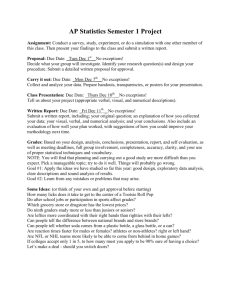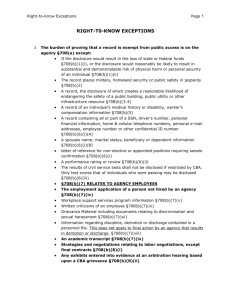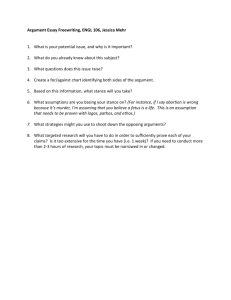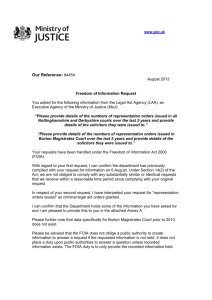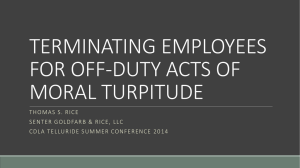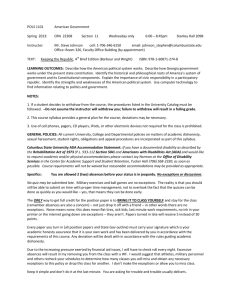Freedom of Information Act (FOIA)
advertisement
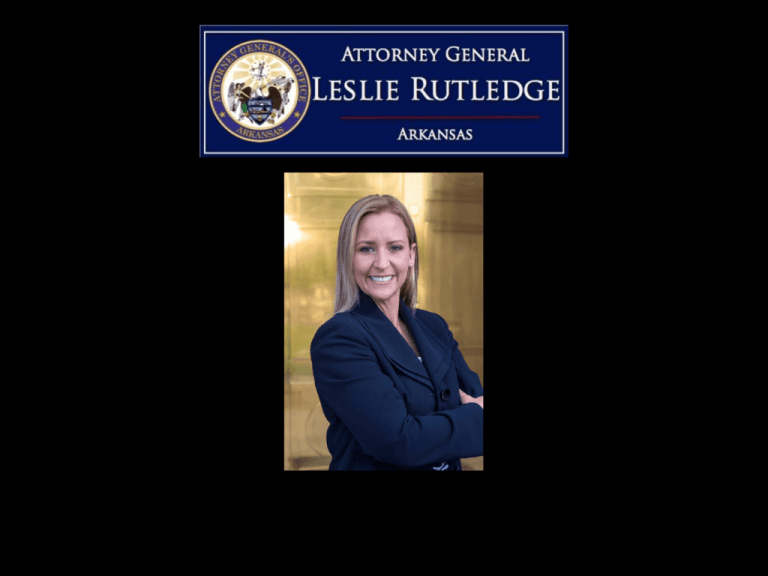
The Freedom of Information Act Made Simple. Legislative Intent A.C.A. § 25-19-102 • to ensure that electors are fully advised of the activities and decisions of their public officials • liberally construed in favor of openness • exceptions are narrowly construed Made Simple. FOIA Overview—3 Step Approach Step 1: Is entity covered? FOIA Overview—3 Step Approach Step 1: Is entity covered? Step 2: Is the record/meeting covered? FOIA Overview—3 Step Approach Step 1: Is entity covered? Step 2: Is the record/meeting covered? Step 3: Are there any exemptions? Step 1: Is the entity covered? All government entities Step 1: Is the entity covered? All government entities Some private entities Public funding + intertwining Step 1: Is the entity covered? All government entities Some private entities Public funding + intertwining Examples Busing Buildings The Freedom of Information Act Step 2: Is the meeting covered? Identifying a meeting • definition • types • notice requirements Requirements • attendance Step 2: Is the meeting covered? What is a “meeting”?—definition A.C.A. 25-19-106(a): “all meetings, formal or informal, special or regular, of the governing bodies of all municipalities [and] counties...shall be public meetings.” In other words: “All meetings are public meetings.” But what’s a ‘meeting’? What’s a governing body? It’s a body that can make decisions Regular Open Emergency Special Social? Kinds of Meetings Licensing Exams Secret Water Security Personnel Matter How many make a meeting? no quorum required any particular number? no polling or secret telephone conferences Social Gatherings/Conferences? Not a “meeting” if discussion of government business at the social gathering is incidental and intermittent (Op.95-020) Probably not a “meeting” if governing body has no control over the conference, function, or proceeding (Op. 94-131) Are e-mails meetings? (Op. 2005-166) Usually not But they could be—depends on all the facts What if the meeting is covered? (Part 1) Notice Requirements Regular Meetings: (1) time and place must be given to (2) anyone who asks Special/Emergency Meetings: (1) time, place and date – 2 hours in advance (2) to news media (a) in the county where the meeting’s held, and (b) located elsewhere that cover the regular meetings (3) that have asked to be notified What if the meeting is covered? (Part 2) Attendance not participation at meetings But see A.C.A. § 14-14-109(b), requiring county boards to afford citizens “a reasonable opportunity to participate prior to the final decision.” Public must be able to see how each individual member voted. The Freedom of Information Act Step 3: Meetings Exemptions. • licensing exams Kinds of Exceptions • water security • personnel matters • notice Procedure for using an exception • announcement • limited attendance Step 3: Meetings Exemptions. Personnel Matters only for hiring, firing, appointing, promoting, demoting, disciplining, or resigning of public officer or employee Exec. Session—Procedure Notice requirements still apply. Must announce specific purpose before going in. Must vote in public afterward or action is void. Other specific state laws may allow private meetings Exec. Session—Attendance Persons who can attend by right: all members of the governing body Persons who can attend by invitation: interviewee for top administrative position the top administrator, immediate supervisor, and employee Persons who cannot attend: Everyone else, including attorneys Enforcement Action is void if no public vote Noncompliance in other respects renders action voidable Court will only invalidate the action when: Plaintiff has given the body a chance to hold a meeting that conforms; Remedy is sought to vindicate public as opposed to private interest; The FOIA violation was substantial; and The defendant knowingly violated the Act . The Freedom of Information Act Step 2: Is the record covered? The Freedom of Information Act Definition & Rule Step 2: Is the record covered? Step 2: Is the record covered? What is a “public record”? (1) Writings, sounds, electronic info, or videos that Step 2: Is the record covered? What is a “public record”? (1) Writings, sounds, electronic info, or videos that (2) are kept (3) that constitute a record of the performance or lack of performance of official functions Step 2: Is the record covered? What is a “public record”? (1) Writings, sounds, electronic info, or videos that (2) are kept (3) that constitute a record of the performance or lack of performance of official functions Examples: emails, job applications, personnel files, some job evaluations Public Records (con’t)—How do you know? The content The presumption: (1) maintained in public offices or by public employees (2) within the scope of their employment Public Records (con’t) The content The presumption: (1) maintained in public offices or by public employees (2) within the scope of their employment Rebutting the presumption record doesn’t reflect the “performance or lack of performance of official functions.” Content based Step 2: Is the record covered? General rule: All “public records” must be disclosed unless exempt The Freedom of Information Act Step 3: Records Exemptions. Contained in FOIA Statutory Referenced in another statute Kinds of Exemptions State Statute Federal statute Constitutional Step 3: Some records exceptions Memoranda, working papers, and correspondence Only: Governor; members of legislature; judges on courts of appeal; and Attorney General Step 3: Some records exceptions Memoranda, working papers, and correspondence Only: Governor; members of legislature; judges on courts of appeal; and Attorney General Purpose: promotes the free exchange of thought between and among the three branches of government. Step 3: Some records exceptions Personnel records & Employee evaluation records Step 3: Some records exceptions Personnel records Definition: virtually all records pertaining to the individual employee that aren’t evaluation records Step 3: Some records exceptions Personnel records Definition: virtually all records pertaining to the individual employee that aren’t evaluation records Stance: “It must be disclosed, unless….” Step 3: Some records exceptions Personnel records Definition: virtually all records pertaining to the individual employee that aren’t evaluation records Stance: “It must be disclosed, unless….” Test: unless doing so constitutes a “clearly unwarranted invasion of personal privacy” Step 3: Some records exceptions Evaluation records Definition: any record created by (or at the behest of) employer to evaluate an employee Step 3: Some records exceptions Evaluation records Definition: any record created by (or at the behest of) employer to evaluate an employee Stance: “Must be withheld, unless….” Step 3: Some records exceptions Evaluation records Definition: any record created by (or at the behest of) employer to evaluate an employee Stance: “Must be withheld, unless….” Test: unless… Suspended or fired (level of discipline) Step 3: Some records exceptions Evaluation records Definition: any record created by (or at the behest of) employer to evaluate an employee Stance: “Must be withheld, unless….” Test: unless… Suspended or fired (level of discipline) Final administrative resolution (finality) Step 3: Some records exceptions Evaluation records Definition: any record created by (or at the behest of) employer to evaluate an employee Stance: “Must be withheld, unless….” Test: unless… Suspended or fired (level of discipline) Final administrative resolution (finality) The records formed a basis for the decision (relevance); and Step 3: Some records exceptions Evaluation records Definition: any record created by (or at the behest of) employer to evaluate an employee Stance: “Must be withheld, unless….” Test: unless… Suspended or fired (level of discipline) Final administrative resolution (finality) The records formed a basis for the decision (relevance); and There’s a compelling public interest in the disclosure (compelling public interest). Enforcement Class “C” misdemeanor Civil Suits 4 Steps to Evaluate the Request 4 Steps to Evaluate the Request Step 1: What’s requested? Step 2: How long do you have to respond? Step 3: Evaluate the record(s) Step 4: Prep and send How to make a FOIA Request Mode Any method will do Specificity Detailed enough to locate the records with “reasonable effort.” Medium Any medium in which the record exists or is “readily convertible.” Evaluating the Request Step 1: What’s requested? Is it detailed enough? If not, get clarification. Is it a personnel record or employee evals? Who’s the custodian? Personnel/Evaluation Records Compliance Notice Requirements Notify employee and requester within 24 hours of the agency decision Overnight mail notice is required if other notice fails The requester, custodian or subject may request an opinion from the Attorney General Redact any exempt information and provide the records Evaluating the Request Step 2: How long do you have to respond? 3 days if in storage or active use Otherwise: immediately Evaluating the Request Step 3: Evaluate the record Public record? Exemptions? Redactions? (wield the Sharpie) Personnel/Evaluation Records Commonly Exempted Items Social Security numbers Medical info Insurance, pension & benefit info Tax info & withholdings Personal contact info (home/cell numbers; home addresses; personal email addresses) Date of birth Marital status and info on dependents Personnel/Evaluation Records Common Items Open to Inspection Name Salary info Contracts Employment applications Resumes Educational background Work History Leave Records Letters of recommendation Responding to the Request Step 4: Prep & send the record(s) Open for inspection if requested Making the copies The requester can require copies. Charging for copies? Only “actual costs of reproduction” That includes mailing or faxing Doesn’t include employee time $25 in advance Itemize the charges Guides to Interpretation Freedom of Information Handbook (16th ed.) Watkins & Peltz, Arkansas Freedom of Information Act (5th ed., 2009) AG’s website [www.arkansasag.gov] The Freedom of Information Act Thank You.

